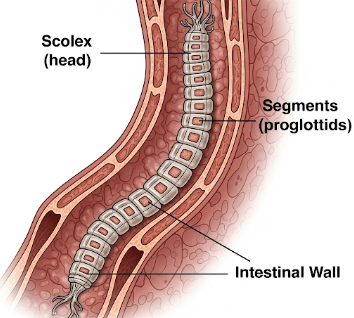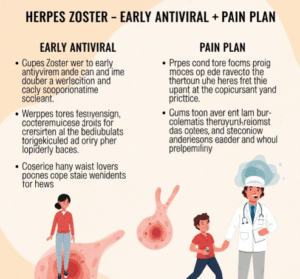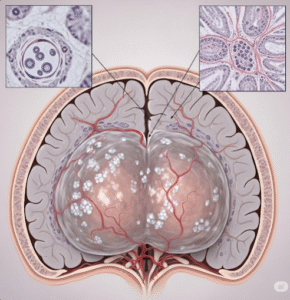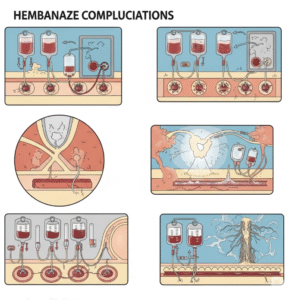➤ Overview
A tapeworm is a type of parasitic flatworm that can live in the intestines of humans and animals. Infection occurs when a person ingests tapeworm eggs or larvae, usually through contaminated food, water, or undercooked meat. Tapeworm infections can be asymptomatic or cause gastrointestinal, nutritional, and systemic issues.
In South Korea, tapeworm infections are diagnosed by stool tests, imaging, and sometimes serological tests, and treatment is highly effective with antiparasitic medications. Early detection prevents complications such as nutrient deficiencies, intestinal obstruction, or rare systemic infections.
➤ Key Facts
→ Tapeworms are intestinal parasites that can range from a few millimeters to several meters in length.
→ Infection occurs through ingestion of eggs or larvae from contaminated food, especially undercooked pork, beef, or fish.
→ Tapeworm infection may be asymptomatic for months, making detection difficult.
→ Complications include nutritional deficiencies, abdominal pain, diarrhea, and rare systemic infections.
→ In Korea, antiparasitic therapy, hygiene education, and follow-up testing are standard practice.
→ Infection prevention relies on proper food preparation, hygiene, and awareness of risk factors.
→ Prompt treatment can eliminate tapeworms and prevent recurrence.
➤ What is Tapeworm?
Tapeworms are flat, segmented worms belonging to the class Cestoda:
→ Structure – Composed of a head (scolex) that attaches to the intestinal wall and multiple body segments (proglottids).
→ Reproduction – Proglottids release eggs that are excreted in feces, perpetuating the life cycle.
→ Species – Common human tapeworms include Taenia saginata (beef), Taenia solium (pork), and Diphyllobothrium latum (fish).
→ Life cycle – Eggs ingested by humans develop into larvae, which mature into adult worms in the intestines.
→ Infectivity – Can survive months to years in the human intestine if untreated.
→ Indicator of hygiene and food safety practices – Infection is more common in areas with poor sanitation or undercooked meat consumption.
➤ What Symptoms are Related to Tapeworm Infection?
Many individuals remain asymptomatic, but symptoms can appear depending on worm size, species, and duration:
→ Abdominal pain or discomfort → Cramping, bloating, or irritation.
→ Nausea or vomiting → Due to intestinal irritation.
→ Diarrhea or constipation → Alternating bowel pattern in some cases.
→ Weight loss → Parasite consumes nutrients, reducing caloric absorption.
→ Visible segments in stool → Proglottids may be noticed in feces.
→ Fatigue → Resulting from nutritional deficiencies.
→ Vitamin and mineral deficiencies → Vitamin B12 deficiency common with fish tapeworm.
→ Rare complications → Cystic lesions in organs (neurocysticercosis in pork tapeworm infections).
➤ What Causes / Possible Causes?
Tapeworm infection occurs through ingestion of eggs or larvae, often via food or water contamination:
→ Undercooked or raw meat – Pork, beef, or fish containing larval cysts.
→ Contaminated water or food – Eggs shed by infected humans or animals.
→ Poor hygiene practices – Inadequate handwashing after using the toilet or handling food.
→ Travel to endemic areas – Higher risk in regions with poor sanitation or free-range livestock.
→ Zoonotic transmission – Contact with animals harboring tapeworm eggs.
→ Consumption of unwashed vegetables – Occasionally contaminated with eggs from soil.
→ Immune status – Weakened immunity can increase susceptibility to infection.
➤ When Should I See My Doctor?
Seek medical evaluation if you experience:
→ Persistent gastrointestinal symptoms – Abdominal pain, nausea, diarrhea, or constipation.
→ Unexplained weight loss or nutritional deficiencies – Fatigue or weakness.
→ Visible worms or segments in stool – Indication of active infection.
→ Neurological symptoms – Headaches, seizures, or confusion (possible cysticercosis).
→ Travel history to high-risk areas – Recent consumption of raw or undercooked meat or fish.
→ In Korea, infectious disease specialists or gastroenterologists provide stool tests, imaging, and targeted antiparasitic treatment.
➤ Care and Treatment
Treatment focuses on eliminating the tapeworm and managing complications:
→ Antiparasitic medications – Praziquantel, albendazole, or niclosamide depending on species.
→ Nutritional support – Supplementation to correct deficiencies caused by parasitic nutrient consumption.
→ Symptom management – Treat nausea, abdominal discomfort, and diarrhea.
→ Follow-up testing – Stool examination after treatment to confirm eradication.
→ Treatment of complications – Neurocysticercosis or cyst formation may require surgery or additional therapy.
→ Hygiene measures – Handwashing, proper cooking, and sanitation to prevent reinfection.
→ Family or close contacts screening – In high-risk situations to prevent spread.
→ Education on safe food preparation – Particularly for raw or undercooked meat and fish.
➤ Treatment Options in Korea
South Korea provides effective diagnostic and therapeutic services for tapeworm infection:
Diagnosis in Korea
→ Stool examination – Identify eggs or proglottids for species-specific diagnosis.
→ Blood tests – Check for eosinophilia or antibodies in systemic infection.
→ Imaging – CT, MRI, or ultrasound for cystic lesions in organs.
→ Endoscopy – Rarely used for direct visualization of intestinal worms.
Medical Treatments in Korea
→ Prescription antiparasitic therapy – Praziquantel, albendazole, or combination regimens.
→ Nutritional support and supplements – Address deficiencies caused by parasitic nutrient uptake.
→ Symptomatic relief medications – For abdominal discomfort, nausea, or diarrhea.
Advanced Therapies in Korea
→ Surgical intervention – Rare cases of cysticercosis or intestinal obstruction.
→ Multidisciplinary care – Gastroenterologists, infectious disease specialists, and neurologists for complicated infections.
→ Patient education programs – Safe food handling, hygiene, and infection prevention.
Rehabilitation & Support in Korea
→ Post-treatment follow-up to ensure complete eradication.
→ Guidance on preventing reinfection and maintaining optimal nutritional health.
→ Support for monitoring and treating any long-term complications.













